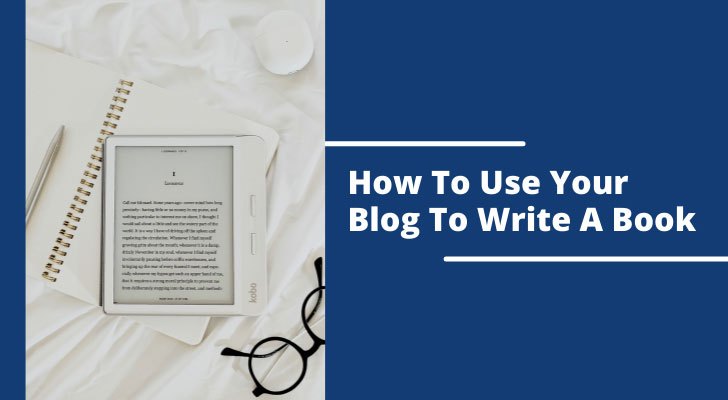If you’re a writer and your dream is to publish a book of your own, then having a blog can be a great way to build an audience. Having an audience is essential if you want people to buy the book that you’ve spent so long writing!
The problem is, that both writing a book and writing a blog takes a lot of work so it can be a real struggle to do both at the same time. Unless that is, you work in a way that lets you do both at the same time.

Reorganize What You’ve Already Done
First off, take a moment to appreciate that your blog is already full of content that can be the foundation of a book. If you’ve been blogging for a while, you’ve likely covered a range of topics, shared insights, and maybe even told stories that have resonated with your readers. All of this is content that can be repurposed into a book. The beauty of using your blog to write a book is that you’re not starting from scratch; you’ve already done a significant portion of the writing.
What you need to do now is start thinking about your blog posts in the context of a book. This means identifying the posts that fit together under a common theme. Maybe you’ve written a series on a particular topic, or perhaps you’ve noticed recurring themes in your writing. These are the threads that can be woven into the chapters of your book.
Find the Common Thread
When you’re using your blog to write a book, the next step is to find the common thread that ties your posts together. This thread will be the theme or main idea of your book. It might be something you’ve already covered extensively on your blog, or it could be a broader concept that ties various posts together.
To do this;
- Start by going through your blog and making a list of posts that you think could be part of a book.
- Don’t worry too much about organizing them just yet—just focus on gathering the material.
As you go through your posts, look for patterns.
- What topics do you return to again and again?
- What questions do your readers frequently ask?
- What do you find yourself most passionate about?
These patterns can help you identify the central theme of your book.
Once you’ve found that common thread, you can begin to see how your blog posts fit into a larger narrative. This is where the idea of a book really starts to take shape. Instead of a collection of individual posts, you’re now thinking about how these posts can work together to tell a bigger story or explore a topic in more depth.
Reorganize Your Content Once Again
With your theme in mind, it’s time to organize your content. This is where you start turning blog posts into book chapters. Go back to the list of posts you made earlier and start grouping them under different headings that could become the chapters of your book.
You might find that some posts naturally go together, while others might need some tweaking to fit into a chapter. Don’t be afraid to rearrange content, merge posts, or even break them up into smaller sections. The goal here is to create a logical flow of ideas that makes sense in a book format.
For example, if your blog is about personal finance, you might have several posts on budgeting, saving, and investing. These could become the main sections of your book, with each post serving as a subtopic within those sections. You might need to write new content to bridge the gaps between posts or expand on ideas that were only briefly mentioned in a blog post.
Fill in the Gaps
No matter how extensive your blog is, you’ll probably find that you need to write some new material to fill in the gaps. While your blog posts provide the foundation, a book requires a more cohesive and comprehensive exploration of the topic.
As you go through your outline, identify where you need to add more content. This might be an introduction to set the stage for the book, transitions between chapters, or deeper dives into topics that were only touched on briefly in your blog. Writing this new content is where you get to expand on ideas and offer more value to your readers.
You might also find that certain blog posts need to be updated or revised for the book. Maybe your views have evolved since you wrote them, or perhaps new information has come to light. Take the time to refine these posts so that they fit seamlessly into your book.
Edit and Polish
Once you’ve pulled together your blog posts and filled in the gaps with new content, it’s time to start editing. Editing a book is different from editing a blog post. You’re not just looking at individual posts anymore—you’re looking at how they work together to create a complete book.
Start by reading through your manuscript as a whole. Look for any sections that feel out of place or redundant. Make sure the book flows logically from one chapter to the next. You might need to add introductions or conclusions to certain chapters to help with this flow.
Next, focus on the details. This is where you fine-tune the language, check for consistency in tone and style, and fix any grammar or punctuation errors. If you’re serious about publishing the book, consider hiring a professional editor to give it a final polish.
Use Your Blog to Promote Your Book
Finally, don’t forget that your blog isn’t just the source of your book’s content—it’s also a great platform for promoting your book once it’s finished. Your readers already know and trust you, so they’re likely to be interested in a book that expands on the content they’ve been following on your blog.
Write a blog post announcing your book and share some behind-the-scenes insights into how it came together. Offer your readers a special discount or bonus content if they purchase the book. You can also use your blog to keep the conversation going by writing new posts that tie into the book’s content.
By turning your blog into a book, you’re not just repurposing old content—you’re creating something new and valuable that offers your readers a deeper, more comprehensive look at the topics they’re interested in. And because you’re building on a foundation you’ve already laid, the process might be easier than you think.

